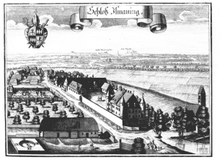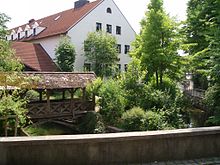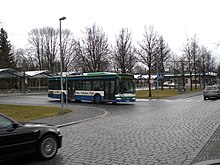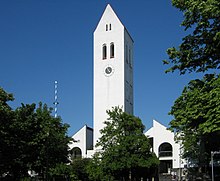Ismaning
| coat of arms | Germany map | |
|---|---|---|

|
Coordinates: 48 ° 14 ' N , 11 ° 40' E |
|
| Basic data | ||
| State : | Bavaria | |
| Administrative region : | Upper Bavaria | |
| County : | Munich | |
| Height : | 490 m above sea level NHN | |
| Area : | 40.2 km 2 | |
| Residents: | 17,376 (Dec. 31, 2019) | |
| Population density : | 432 inhabitants per km 2 | |
| Postal code : | 85737 | |
| Area code : | 089 | |
| License plate : | M , AIB , WOR | |
| Community key : | 09 1 84 130 | |
| LOCODE : | DE IMG | |
| Address of the municipal administration: |
Schlossstrasse 2 85737 Ismaning |
|
| Website : | ||
| Mayor : | Alexander Greulich ( SPD ) | |
| Location of the municipality of Ismaning in the Munich district | ||
Ismaning is a municipality in the north of the district of Munich in the administrative district of Upper Bavaria . The place of the same name is both the capital and the seat of the municipal administration.
The place is about seven kilometers northeast of Munich on the right high bank of the Isar . The originally agricultural community has been known as an important media location since the mid-1990s. The Ismaning transmitter of the Bavarian Broadcasting Corporation has been located northeast of the village since 1932 . In the south is the Medienpark with Sport1 Medien AG ( Sport1 ), Gong-Verlag , Mainstream Media AG ( Heimatkanal ) and the private radio station Antenne Bayern .
geography
Community structure
The settlement area is largely concentrated in the main town of Ismaning, which itself is subdivided into unnamed districts. The only other part of the municipality is the Fischerhäuser settlement , which is around five kilometers north of the main town.
Neighboring communities
The municipality borders in the north on the communities Eching , Hallbergmoos and the Hallbergmooser district Erching (all three districts Freising ), in the east on the communities Moosinning and Finsing (both districts Erding ), in the south on the communities Aschheim and Unterföhring (both districts Munich ) and in the west to the city of Garching near Munich (also district of Munich) and to the city of Munich .
Ismaning is a member of the Northern Alliance , an informal association of eight municipalities in the north of Munich.
history
timeline
- 6./7. Century: first Bavarian settlement
- 809: first documented mention of a dispute settlement by Bishop Atto
- 1319: Sale of the villages of Ismaning, Unterföhring , Oberföhring , Englschalking and Daglfing to the Hochstift Freising by the Duke of Bavaria and later German Emperor Ludwig the Bavarian for “one hundred March lotrings silver”. This created the county on the Yserrain as a closed domain of the Freising bishops.
- In 1530, Bishop Philipp von Freising took over from the Haushaimern , a Freising canon family , their Ismaning country estate and built a renaissance castle with four towers. The county of Yserrain became the imperial county of Ismaning.
- In 1632 Swedish troops plundered and pillaged Ismaning during the Thirty Years' War . More than half of the residents died of the plague in the subsequent period .
- 1678–1685: Construction of the baroque Johanniskirche
- 1716–1724: Baroque remodeling of the Ismaning Palace under Prince-Bishop Johann Franz Eckher with decisive involvement of Johann Baptist Zimmermann
- 1802–1803 ended the secularization of the almost 500-year-old era of the Freising prince-bishops; the Hochstift Freising was dissolved, Ismaning became part of the Electorate of Bavaria. The castle and its furnishings were partially destroyed.
- In 1816 Napoleon's stepson , Eugène de Beauharnais , and his wife Auguste Amalie , daughter of the Bavarian King Maximilian I , took over the Ismaning Palace and had it redesigned in a classicist manner by Leo von Klenze .
- Auguste Amalie died in 1851. The castle changed hands several times.
- From 1899 to 1919 Ismaninger Castle was owned by the City of Munich .
- 1932: The Ismaning transmitter goes into operation.
- 26.-28. April 1945: Rebellion of the Bavarian Freedom Campaign (FAB)
- In 1983 the wooden transmission tower in Ismaning, the last of its kind in Germany, which had been out of order for a long time, was demolished due to its disrepair.
Population statistics
Ismaning was the most populous municipality in the northern district of Munich until the 1970s, but was then surpassed by Unterschleißheim and Garching due to self-imposed reluctance to grow. Nevertheless, the number of inhabitants is increasing steadily.
|
|
|
Source: Municipal statistics 2011 (PDF; 1.3 MB)
From the 1930s onwards, the main settlements were to the west and from the 1950s onwards north of the core village. Because settlement boundaries were reached here - in the west through the Isarauen landscape protection area - the designation of new residential areas has recently shifted to the eastern local area between the railway line and the federal highway 471 .
Denomination statistics
According to the 2011 census , 13.6% of the population were Protestant , 49.6% Roman Catholic and 36.6% were non-denominational , belonged to another religious community or did not provide any information. As of December 31, 2019, 17,591 people were living in Ismaning, of whom 2,123 (12.1%) were Protestants, 7,639 (43.4%) were Roman Catholics and 44.5% were non-denominational or belong to another religious community.
politics
Municipal council
The municipal council has 24 members:
| choice | SPD | Free voters | CSU | Green | FDP |
|---|---|---|---|---|---|
| March 15, 2020 | 7 seats | 6 seats | 6 seats | 4 seats | 1 seat |
| March 16, 2014 | 8 seats | 7 seats | 7 seats | 2 seats | - |
| March 2, 2008 | 6 seats | 11 seats | 5 seats | 2 seats | - |
| March 3, 2002 | 6 seats | 10 seats | 7 seats | 1 seat | - |
mayor
In local politics, Ismaning was shaped for many years by Mayor Erich Zeitler (SPD), who was first elected to office in 1952 and retired in 1990 as the longest serving mayor in Bavaria after 38 years of service. He was succeeded by Michael Sedlmair (Free Voters), who did not run again in the 2014 local elections after four terms. In 2014, Alexander Greulich (SPD) was elected First Mayor of Ismaning, who was able to prevail in a runoff election against Josef Zettl (CSU). Greyish was confirmed in office in the 1st ballot in 2020.
For former mayors or community leaders of Ismaning → List of Mayors of Ismaning
State elections
Ismaning is assigned to the district of Munich-Land-Nord (122) in state elections . In the state elections in 2003, 2008 and 2014, the CSU received most of the overall votes in Ismaning, but its share of the vote remained well below the average in the district of Munich-Land Nord and the national average. The free voters who provided the mayor of Ismaning from 1990 to 2014 performed above average.
| State election September 21, 2003 |
Ismaning | vs. Constituency |
vs. Bavaria |
|---|---|---|---|
| voter turnout | 63.4% | + 2.0% P. | + 6.3% P. |
| CSU | 48.7% | −6.2% P | −12.0% P. |
| SPD | 22.6% | −1.6% P. | + 3.0% P. |
| FW | 14.3% | + 10.4% P. | + 10.3% P. |
| Green | 9.1% | −0.8% P | +1.4% P. |
| FDP | 2.5% | −1.2% P. | −0.1% P |
| State election September 28, 2008 |
Ismaning | vs. Constituency |
vs. Bavaria |
|---|---|---|---|
| voter turnout | 63.6% | +1.2% P | + 5.7% P. |
| CSU | 32.0% | −4.5% P. | −11.4% P. |
| SPD | 19.0% | −4.6% P. | + 0.4% P. |
| FW | 23.5% | + 14.7% P. | + 13.3% P. |
| Green | 10.6% | −0.4% P | +1.2% P |
| FDP | 8.3% | −4.1% P. | + 0.3% P. |
| State election September 15, 2013 |
Ismaning | vs. Constituency |
vs. Bavaria |
|---|---|---|---|
| voter turnout | 72.9% | + 2.9% P. | + 9.6% P. |
| CSU | 38.3% | −6.2% P | −9.4% P. |
| SPD | 21.5% | −4.2% P | + 0.9% P. |
| FW | 21.5% | + 13.6% P. | + 12.5% P. |
| Green | 8.6% | −0.7% P. | + 0.0% P. |
| FDP | 3.4% | −0.9% P. | + 0.1% P. |
Bundestag elections
Ismaning is assigned to the Munich-Land constituency in federal elections (in 2005 constituency number 223, in 2009 constituency number 222 identical to the area). In the Bundestag elections in 2005 and 2009, the share of second votes in Ismaning was slightly below the national average in Bavaria, and the SPD in the 2013 election. The FDP and the Greens were above this in all elections. The turnout in Ismaning is regularly well above the national average.
| Bundestag election September 18, 2005 |
Ismaning | vs. Constituency |
vs. Bavaria |
|---|---|---|---|
| voter turnout | 83.1% | −0.4% P | + 5.2% P. |
| CSU | 45.6% | + 0.2% P. | −3.6% P. |
| SPD | 26.3% | + 2.3% P. | + 0.8% P. |
| FDP | 11.9% | −2.7% P. | + 2.4% P. |
| Green | 10.2% | −0.5% P | + 2.3% P. |
| left | 2.8% | + 0.2% P. | −0.6% P. |
| Bundestag election September 27, 2009 |
Ismaning | vs. Constituency |
vs. Bavaria |
|---|---|---|---|
| voter turnout | 79.7% | + 0.6% P. | + 8.1% P. |
| CSU | 40.8% | +1.0% P | −1.7% P. |
| SPD | 16.9% | + 0.2% P. | + 0.1% P. |
| FDP | 16.8% | −2.9% P. | + 2.1% P. |
| Green | 13.2% | + 0.5% P. | + 2.4% P. |
| left | 4.8% | + 0.3% P. | −1.7% P. |
| Bundestag election September 22, 2013 |
Ismaning | vs. Constituency |
vs. Bavaria |
|---|---|---|---|
| voter turnout | 77.7% | + 0.2% P. | + 7.7% P. |
| CSU | 46.9% | + 0.0% P. | −2.4% P. |
| SPD | 20.9% | + 0.4% P. | + 0.0% P. |
| FDP | 6.5% | −2.0% P. | +1.4% P. |
| Green | 9.9% | + 0.0% P. | +1.5% P. |
| left | 3.0% | + 0.2% P. | −0.8% P |
| Bundestag election September 24, 2017 |
Ismaning | vs. Constituency |
vs. Bavaria |
|---|---|---|---|
| voter turnout | 84.6% | + 0.2% P. | + 6.4% P. |
| CSU | 37.9% | + 0.6% P. | −0.9% P. |
| SPD | 14.4% | + 0.4% P. | −0.9% P. |
| FDP | 12.8% | −2.5% P. | + 2.6% P. |
| Green | 11.9% | −0.7% P. | + 2.1% P. |
| left | 5.1% | 0.0% P | −1.0% P |
| AfD | 9.1% | −0.3% P | -3.3% P |
coat of arms
|
Blazon : “Divided by silver and black; above a red crowned black Moor's head on a red base, below three silver diamonds standing side by side. "
The coat of arms of the municipality of Ismaning, designed by Otto Hupp , dates from 1929 and represents the centuries-old ties to the city of Freising . In the upper part of the shield you can see a moor with a red crown, which originally comes from the coat of arms of the bishopric of the same name . Bishop Otto von Freising is said to have earned the right to wear a Moor in his coat of arms by participating in the Second Crusade . In the lower part of the shield there are three silver diamonds ( called Wecken ) next to each other . They come from the family coat of arms of Prince-Bishop Johann Franz Eckher , the builder of Ismaning Castle . |
|
economy
The community was characterized by agriculture and small businesses until the middle of the 20th century, the only industry-like employers around 1900 were a paper factory on Seebach, as well as two brickworks and two herb factories. Around 1960 the ceramic production company Agrob was the largest company in the area. The further economic development was determined from the 1980s by the proximity to the city of Munich and thus by the settlement of companies from the service segment: The number of farms fell between 1979 and 2007 from 115 to 82, which today has around 12,500 jobs in the municipality More than two-thirds are to be assigned to the service sector. After production was discontinued in 1990, the former Agrob site became a media center with Home Shopping Europe , Antenne Bayern , Sport 1 , Gong Verlag , Hueber Verlag (moving back to Munich). Ismaning was also the seat of Kirchmedia , the German Apple branch and the Munich Telecommunications School for a time .
For a municipality without a traditional tourist orientation, Ismaning has an unusually high number of accommodation establishments and overnight stays. This is explained by the location halfway between the state capital and the airport, which can be reached in less than 15 minutes by S-Bahn. In 2001, a local record of more than 200,000 overnight stays was counted; in 2009 the ten hotels in Ismaning achieved around 165,000 overnight stays. The length of stay per guest is continuously an average of around two days.
The BMW test site on the reservoir is also often associated with Ismaning, but is actually in the area of the neighboring municipality of Aschheim.
traffic
Ismaning is well developed due to its location near Munich. Ismaning is located on the Munich East – Munich Airport railway line , the 99 Federal Motorway , the B 471 , B 388 and B 301 federal highways and State Road 2053 (Freising – Ismaning – Unterföhring – Munich).
The S8 line of the Munich S-Bahn connects Ismaning with Munich every 20 minutes (travel time to the center around 25 minutes) and the airport (travel time around 15 minutes). The aforementioned railway line runs in the center of Ismaning in a tunnel, so Ismaning station is also underground. Its construction took place in the course of the S-Bahn extension to the new Munich airport. A green corridor was mostly laid out on the tunnel .
Ismaning also has bus connections to the student town of Freimann (line 231), to Garching (line 230), Erding (line 531) and in the direction of Aschheim and Haar (line 285).
Culture and sights
See also: List of architectural monuments in Ismaning and List of ground monuments in Ismaning
Many neighboring communities emerged as street villages and did not develop a dominant center (e.g. Unterföhring, Aschheim) or have only recently created this in planning (e.g. Garching). On the other hand, Ismaning has a historically grown village center away from the thoroughfare, in which numerous functional buildings are located in a spatial context.
This center is shaped by the Catholic parish church of St. Johann Baptist . It is located between Ismaning Castle to the north (with the castle park and former farm buildings) and the adjoining school buildings with gymnasiums to the south which, together with the Protestant church, enclose the large schoolyard. Churches and school buildings are modern buildings, with the exception of the so-called "old girls' school" - today the location of the music school. Next to the church on Ortsbach Seebach are the listed Gasthof zur Mühle with beer garden and old trees, as well as the war memorial on the church square and the rectory, both also listed in the Bavarian list of monuments.
Other listed or well-known buildings and facilities in the municipality are the water tower built in 1913 , the major Bavarian radio station for VHF and medium wave around two kilometers northeast of Ismaning, the Allianz Center for Technology with its in-house "Museum of Misfortunes" and some historical memorial columns, see above the wayside shrine for the victims of the plane crash of August 25, 1918 , the plague column or the memorial stone for the victims of the raft accident of May 21, 1907 .
The main building of the palace is now the seat of the municipal administration, museums and galleries are housed in the former economy and auxiliary buildings: the Kallmann Museum on the square and in the style of a former orangery, the palace museum with its local history exhibition and the palace pavilion for changing art exhibitions. The “Citizens' Hall” built in the 1980s near the center of the village is used for larger cultural events. A communal cultural center with a communal library and adult education center was set up in 2009 in the listed Seidl mill south of the village center.
Educational institutions
In Ismaning there were four kindergartens, three elementary schools (Hauptschule on Freisinger Straße, Elementary School am Kirchplatz and the Camerloherstraße Elementary School, established in 1995) with around 760 students and 50 teachers, a Waldorf School with 440 students and 34 teachers and one Realschule with around 650 students and 40 teachers. The community is a member of the school association for the Werner-Heisenberg-Gymnasium in neighboring Garching. After two school years in addition to the Realschule in Ismaning containers there were precursor classes, the Ismaning grammar school became independent in August 2017. In September 2017, regular school operations in the new school building began as planned.
Historically, school lessons in Ismaning are documented for the first time in 1610, but the first schoolhouse was not built until 1835 when the benefit house south of the church was rebuilt. This first school was increased by one floor in 1875 and another floor in 1904. The building served as a boys 'school until 1957, then it was demolished and a new girls' school with eight classrooms was built in the same place. In 1967 it was expanded to include six additional classrooms and is now the primary school on Kirchplatz. Originally, the girls' school was operated from 1886 in two rooms in the nurses' house next to the church, and a first girls' school was built in 1912 (today a music school). In 1957, after the building on Kirchplatz was demolished, the boys' school moved to a new building on Freisinger Strasse, the eight classrooms of which were supplemented by an extension with nine classrooms in 1967. Today this school complex is the secondary school on Freisinger Straße in the immediate vicinity of the Ismaning State Secondary School, built in 1977.
The University of Applied Management has had its headquarters in Ismaning in the Triagon building on Steinheilstrasse since 2015 .
Sports
The Ismaninger Winter Run series takes place every year in December, January and February.
Sons and daughters of the church
- Dr. Jakob Haushaimer (-1519), Vicar General
- Otto Braun (1900–1974), writer
- Erich Greipl (1940–2013), trade manager
- Nikolaus Kraus (* 1965), farmer and politician, member of the Bavarian State Parliament
- Brigitte Hobmeier (* 1976), actress
- Sophie Fasold (* 1994), handball player
literature
- Therese Risinger: Ismaning - history of a village . Ismaning 2004, an extensively researched documentation of this place.
- Cornelia Oelwein: Between Goldach and Seebach . The history of the Goldachhof and moss cultivation in Ismaning. Verlag Franz Schiermeier, Munich 2013, ISBN 978-3-943866-22-3 .
Web links
- Local government
- Ismaning: Official statistics of the LfStat (PDF; 1.7 MB)
Individual evidence
- ↑ "Data 2" sheet, Statistical Report A1200C 202041 Population of the municipalities, districts and administrative districts 1st quarter 2020 (population based on the 2011 census) ( help ).
- ↑ Municipal statistics 2011
- ^ City of Ismaning Religion , 2011 census
- ^ City of Ismaning Citizens' Assembly 2020 , accessed on May 3, 2020
- ↑ Mayor, local council and parliamentary groups. Ismaning municipality, accessed on August 26, 2020 .
- ^ Entry on Ismaning's coat of arms in the database of the House of Bavarian History
- ↑ Hueber Verlag moves from Ismaning to Munich-Moosach
- ↑ Museum of Misfortunes
- ↑ https://www.wochenanzeiger.de/article/168994.html
- ↑ http://winterlaufserie.net/











